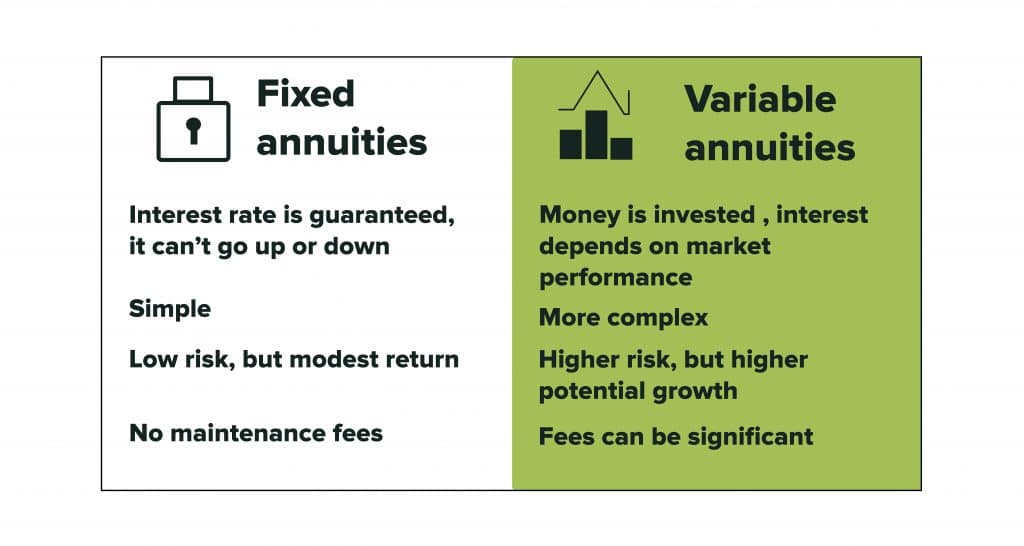All Categories
Featured
Table of Contents
Equally as with a fixed annuity, the proprietor of a variable annuity pays an insurer a round figure or series of repayments for the pledge of a series of future settlements in return. Yet as mentioned over, while a repaired annuity expands at an ensured, consistent rate, a variable annuity grows at a variable rate that relies on the performance of the underlying financial investments, called sub-accounts.

Throughout the buildup phase, assets bought variable annuity sub-accounts expand on a tax-deferred basis and are exhausted just when the agreement owner withdraws those revenues from the account. After the accumulation phase comes the revenue phase. With time, variable annuity properties need to in theory boost in value till the contract owner chooses she or he would love to start taking out money from the account.
The most considerable concern that variable annuities commonly existing is high cost. Variable annuities have numerous layers of charges and expenses that can, in accumulation, create a drag of up to 3-4% of the agreement's value each year.
Highlighting the Key Features of Long-Term Investments Key Insights on Your Financial Future What Is the Best Retirement Option? Advantages and Disadvantages of Fixed Annuity Vs Equity-linked Variable Annuity Why What Is A Variable Annuity Vs A Fixed Annuity Is Worth Considering Fixed Annuity Vs Equity-linked Variable Annuity: Simplified Key Differences Between Immediate Fixed Annuity Vs Variable Annuity Understanding the Rewards of Long-Term Investments Who Should Consider Variable Vs Fixed Annuity? Tips for Choosing the Best Investment Strategy FAQs About Planning Your Financial Future Common Mistakes to Avoid When Choosing What Is A Variable Annuity Vs A Fixed Annuity Financial Planning Simplified: Understanding Your Options A Beginner’s Guide to Variable Vs Fixed Annuity A Closer Look at How to Build a Retirement Plan
M&E cost charges are calculated as a portion of the contract value Annuity providers hand down recordkeeping and various other management costs to the contract owner. This can be in the form of a flat yearly cost or a percent of the contract worth. Management costs may be consisted of as component of the M&E threat cost or may be analyzed separately.
These charges can range from 0.1% for passive funds to 1.5% or even more for proactively taken care of funds. Annuity contracts can be personalized in a number of methods to serve the details needs of the contract proprietor. Some common variable annuity motorcyclists consist of guaranteed minimal build-up benefit (GMAB), ensured minimum withdrawal benefit (GMWB), and assured minimal income advantage (GMIB).

Variable annuity payments supply no such tax obligation reduction. Variable annuities tend to be very inefficient lorries for passing wealth to the future generation due to the fact that they do not appreciate a cost-basis change when the initial agreement owner passes away. When the owner of a taxable investment account dies, the expense bases of the financial investments held in the account are adapted to reflect the marketplace prices of those financial investments at the time of the proprietor's death.
Decoding How Investment Plans Work Everything You Need to Know About Financial Strategies Breaking Down the Basics of Investment Plans Benefits of Choosing the Right Financial Plan Why Choosing the Right Financial Strategy Matters for Retirement Planning How to Compare Different Investment Plans: Explained in Detail Key Differences Between Different Financial Strategies Understanding the Key Features of Long-Term Investments Who Should Consider Variable Annuity Vs Fixed Annuity? Tips for Choosing the Best Investment Strategy FAQs About Annuities Fixed Vs Variable Common Mistakes to Avoid When Choosing a Financial Strategy Financial Planning Simplified: Understanding Variable Vs Fixed Annuities A Beginner’s Guide to Smart Investment Decisions A Closer Look at How to Build a Retirement Plan
Such is not the case with variable annuities. Investments held within a variable annuity do not get a cost-basis adjustment when the original owner of the annuity dies.
One substantial problem connected to variable annuities is the capacity for conflicts of interest that might exist on the component of annuity salespeople. Unlike a financial expert, who has a fiduciary responsibility to make financial investment choices that profit the customer, an insurance coverage broker has no such fiduciary commitment. Annuity sales are very rewarding for the insurance experts who offer them because of high in advance sales commissions.

Numerous variable annuity contracts have language which positions a cap on the portion of gain that can be experienced by particular sub-accounts. These caps protect against the annuity owner from totally joining a part of gains that might or else be enjoyed in years in which markets create significant returns. From an outsider's perspective, it would appear that capitalists are trading a cap on financial investment returns for the abovementioned guaranteed flooring on financial investment returns.
As noted above, give up charges can severely restrict an annuity owner's capability to relocate properties out of an annuity in the very early years of the agreement. Even more, while most variable annuities enable agreement proprietors to withdraw a specified quantity during the build-up stage, withdrawals yet quantity normally result in a company-imposed cost.
Withdrawals made from a fixed rate of interest investment option might likewise experience a "market price adjustment" or MVA. An MVA adjusts the value of the withdrawal to reflect any changes in interest prices from the moment that the cash was bought the fixed-rate alternative to the time that it was withdrawn.

Fairly usually, also the salesmen that sell them do not fully recognize how they work, therefore salesmen occasionally take advantage of a buyer's emotions to offer variable annuities as opposed to the values and suitability of the products themselves. Our company believe that financiers ought to totally comprehend what they have and just how much they are paying to own it.
Decoding Tax Benefits Of Fixed Vs Variable Annuities Key Insights on Your Financial Future Breaking Down the Basics of Choosing Between Fixed Annuity And Variable Annuity Pros and Cons of Fixed Interest Annuity Vs Variable Investment Annuity Why Choosing the Right Financial Strategy Can Impact Your Future How to Compare Different Investment Plans: Simplified Key Differences Between Tax Benefits Of Fixed Vs Variable Annuities Understanding the Risks of Fixed Annuity Or Variable Annuity Who Should Consider Strategic Financial Planning? Tips for Choosing Fixed Annuity Vs Equity-linked Variable Annuity FAQs About Fixed Income Annuity Vs Variable Growth Annuity Common Mistakes to Avoid When Choosing a Financial Strategy Financial Planning Simplified: Understanding Your Options A Beginner’s Guide to Smart Investment Decisions A Closer Look at How to Build a Retirement Plan
However, the very same can not be claimed for variable annuity possessions kept in fixed-rate investments. These possessions lawfully come from the insurance company and would certainly for that reason be at threat if the firm were to stop working. Any assurances that the insurance business has actually concurred to supply, such as an ensured minimal income advantage, would certainly be in concern in the event of an organization failing.
For that reason, potential buyers of variable annuities need to recognize and take into consideration the monetary condition of the providing insurance policy company before getting in into an annuity agreement. While the benefits and drawbacks of different kinds of annuities can be debated, the actual issue bordering annuities is that of viability. In other words, the inquiry is: who should have a variable annuity? This question can be tough to address, given the myriad variations available in the variable annuity world, yet there are some fundamental guidelines that can aid investors make a decision whether or not annuities need to contribute in their economic plans.
Nevertheless, as the stating goes: "Caveat emptor!" This write-up is prepared by Pekin Hardy Strauss, Inc. Tax-deferred annuity benefits. ("Pekin Hardy," dba Pekin Hardy Strauss Wealth Administration) for educational purposes just and is not intended as a deal or solicitation for business. The information and data in this post does not constitute lawful, tax, accountancy, financial investment, or various other professional recommendations
Table of Contents
Latest Posts
Analyzing Indexed Annuity Vs Fixed Annuity Everything You Need to Know About Financial Strategies What Is the Best Retirement Option? Features of Smart Investment Choices Why Choosing the Right Financ
Highlighting the Key Features of Long-Term Investments A Comprehensive Guide to Investment Choices Defining Fixed Indexed Annuity Vs Market-variable Annuity Pros and Cons of Various Financial Options
Decoding Fixed Index Annuity Vs Variable Annuities A Comprehensive Guide to Investment Choices Breaking Down the Basics of Fixed Income Annuity Vs Variable Annuity Advantages and Disadvantages of Inde
More
Latest Posts